|
HIERONYMUS BOSCH - THE GARDEN OF EARTHLY
DELIGHTS

Hieronymus Bosch, Public domain, via Wikimedia Commons
c. 1490–1510
The wood has ears, the field has eyes |
- A triptych oil painting on oak panel painted by the Early Netherlandish master Hieronymus Bosch, between 1490 and 1510.
- It has resided in the Museo del Prado in Madrid, Spain since 1939.
- Triptychs from this period were generally intended to be read sequentially, the left and right panels often portraying Eden and the Last Judgment respectively, while the main subject was contained in the centerpiece.
- Each panel was essential to the meaning of the whole.
Bosch's religious beliefs are unknown, but interpretations of the work typically assume it is a warning against the perils of temptation. Twentieth-century art historians are divided as to whether the triptych's central panel is a moral warning or a panorama of the paradise lost. (Wikipedia)
|
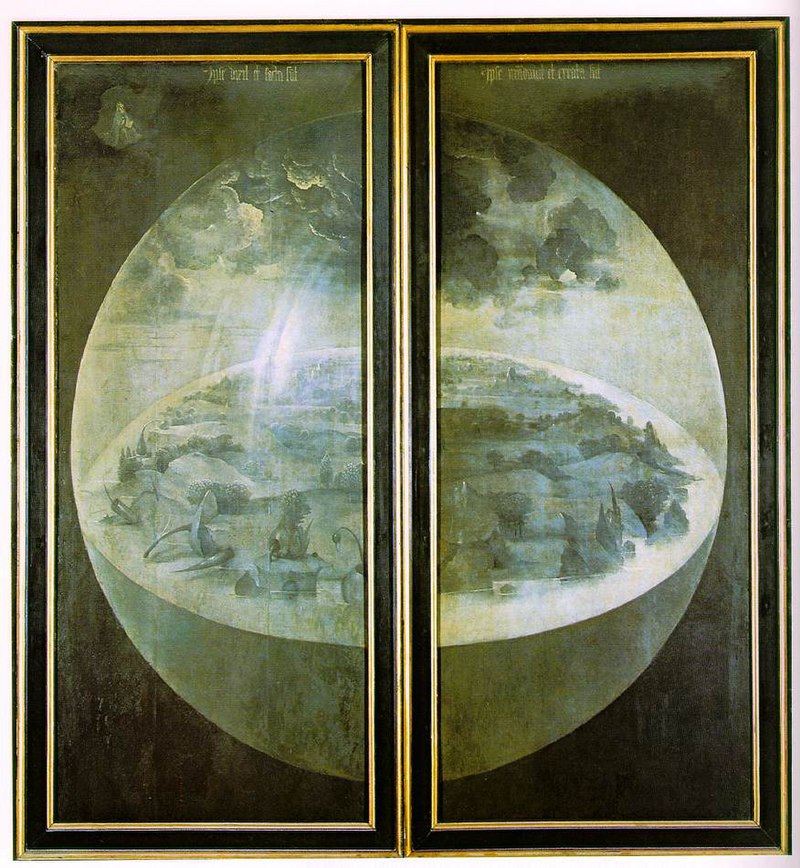
Hieronymus Bosch, Public domain, via Wikimedia Commons
|
- The exterior panels show the world during creation, probably on the Third Day, after the addition of plant life but before the appearance of animals and humans.
- It is not known whether The Garden was intended as an altarpiece, but the general view is that the extreme subject matter of the inner center and right panels make it unlikely that it was planned for a church or monastery.
The outer panels are generally thought to depict
the creation of the world, showing greenery beginning
to clothe the still-pristine Earth. God, wearing a
crown similar to a papal tiara (a common convention in
Netherlandish painting), is visible as a tiny figure
at the upper left. Bosch shows God as the father
sitting with a Bible on his lap, creating the Earth in
a passive manner by divine fiat. (Wikipedia)
|
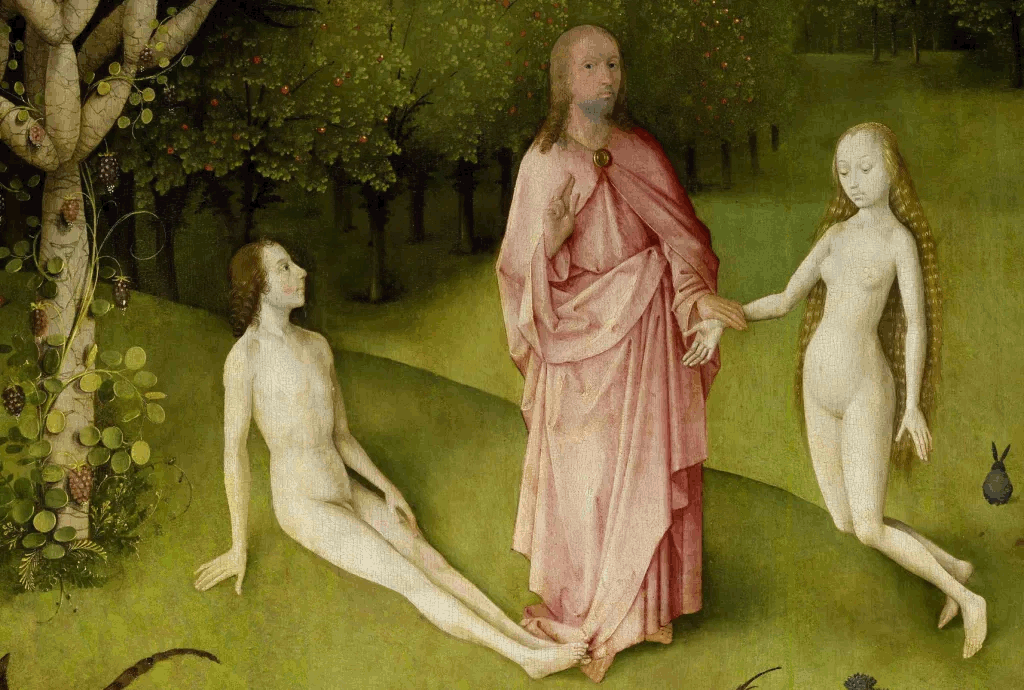
Joining of
Adam and Eve |
- Jesus is Phanes Protogonus the Lightbringer and
Firstbegtten.
- Showing God as Christ, presenting Eve to Adam and blessing their union.
- The left panel depicts a scene from the paradise of the Garden of Eden commonly interpreted as the moment when God presents Eve to Adam.
- The painting shows Adam waking from a deep sleep to find God holding Eve by her wrist and giving the sign of his blessing to their union.

Phallic fountain of
life |
- This is 'nuditas naturalis,' which is the natural state of man as he is born into the world
which is the natural, original, sinless state of Adam and Eve in the Garden of Eden before their Original Sin.
- Some historians believe the three inner panels seek to
broadly convey the Old Testament notion that, before the Fall,
there was no defined boundary between good and evil; humanity
in its innocence was unaware of consequence.
In the beginning was the Word (Logos), and the
Word was with God (Theon), and the Word was God
(Theos). He was with God (Theon) in the beginning).
Through him all things were made; without him nothing
was made that has been made. (John 1:1-3)
|
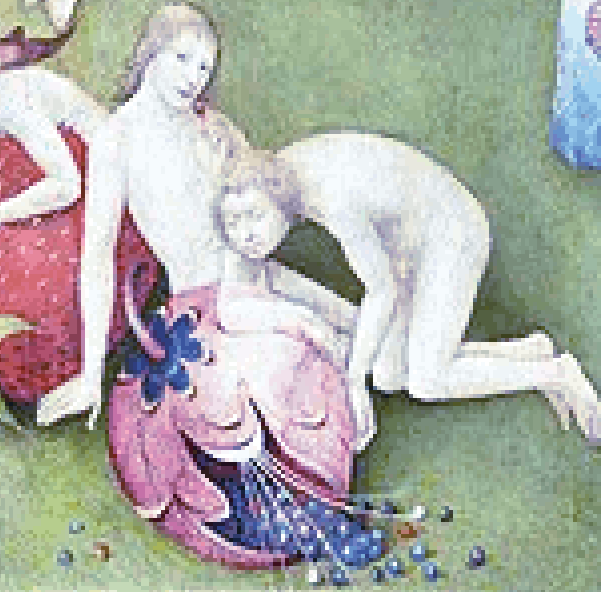
Pleasure-seeking |
- In contrast to Bosch's two other extant triptychs, God is absent from the central panel.
- Instead, this panel shows humanity acting with apparent free will as naked men and women engage in various pleasure-seeking activities.
- Strawberry represents beautiful but unfaithful women, or morally-corrupting pleasure.
The idea that souls in the afterlife have physical substance, to enjoy the pleasures of heaven or suffer the punishments of hell, was commonplace in the early church and remained in Bosch’s day. They believed that, just as Jesus in the Gospels had a physical resurrection and ascended bodily into heaven, so the souls of all will be raised physically, in the condition of the prime of life, to meet their eternal fate. The statements of three Church Fathers will suffice to represent the many expressing the same ideas. (earlymusicmuse.com6)
|

Delight in nature |
- The middle
panel represents 'nuditas criminalis, because the middle panel has often been taken to be sinful humanity before God sent the great flood to wipe out all humankind except Noah and his family.
- Among the many symbolic details Bosch used to illustrate humanity’s delight in sin are animals, fruit and flowers.
Yet for us there is but one God (Theos), the
Father, from whom all things came and for whom we
live; and there is but one Lord (Kyrios), Jesus
Christ, through which all things came and through whom
we live. (1 Corinthians 8:6)
|

Sinful humanity |
- A small owl is perched on the horn of a hybrid one-horned creature, one of the animals being ridden in a large circle around the central pool.
- All the cherries shown throughout the painting are symbols
of sexual lust.
You who cull flowers and low-growing strawberries,
Away from here, lads; a chill snake lurks in the grass. (Virgil)
|
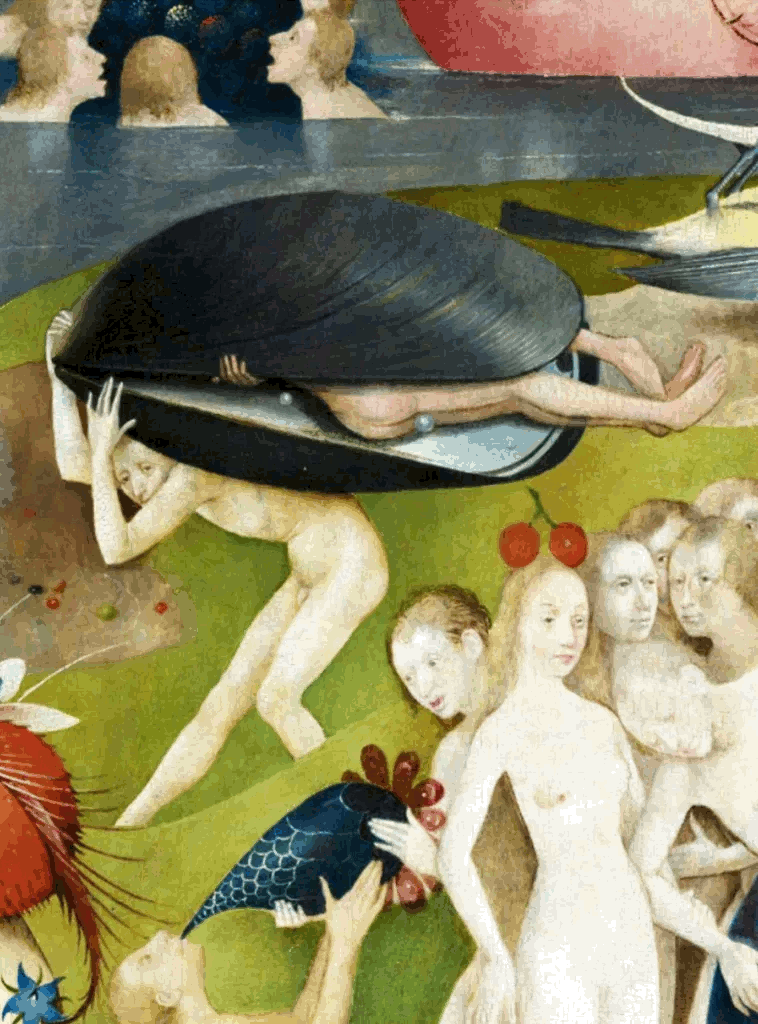
Mussel |
- We see a man carrying a huge mussel on his back, symbol of sexual desire
and there seems to be a couple inside the shell.
- Because
there are black and white figures, this represents all of
humankind in a sinful state.
- A cherry was one of the standard representations of carnal lust and, as on the head of the woman,
whereas two cherries on a stalk were a phallic symbol and are
shown elsewhere in the painting.
The suggestion appears to be that the man carrying the mussel shell is weighed down by his sexual cravings. Both clams and similar but distinctive oysters have been associated with sexual desire for millennia. Oysters were (and still are, by reputation) considered aphrodisiacs, associated with Aphrodite (Greek name) or Venus (Roman name), the goddess of beauty, love and fertility. Aphrodite/Venus was created from the union of the testicles of the castrated sky god, Uranus, which had fallen into the sea, mixed with sea foam, symbolic of sperm, and she arrived on the shore of Cyprus, fully formed inside an oyster shell. (earlymusicmuse.com6)
|
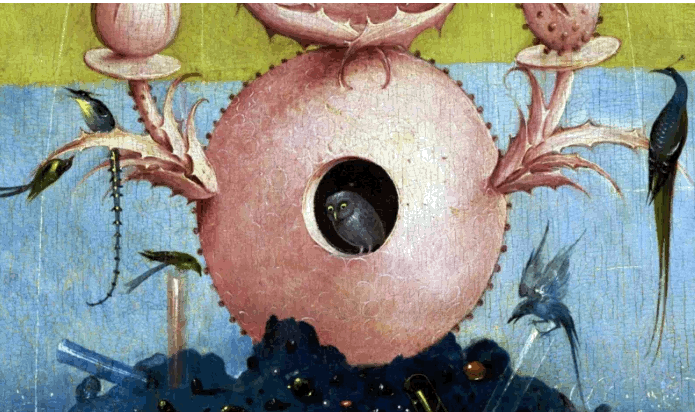
Fountain of life |
- Bosch painted a small owl in the center of the fountain of life, signifying the potential from the beginning of overturning God’s paradise.
A sinner on his back, who offers a cherry to a raven which, according to the bestiaries, attacks by pecking out eyes, destroying the ability to see, just as the devil first destroys the ability to judge correctly. (earlymusicmuse.com6)
|

Hellscape |
- According to some interpretations, the right-hand panel is believed to show God's penalties in a hellscape.
- The tone of this final panel strikes a harsh contrast to those preceding it.
- The scene is set at night, and the natural beauty that adorned the earlier panels is noticeably absent.
Though I know that evening's empire has returned into sand
Vanished from my hand
Left me blindly here to stand, but still not sleeping
My weariness amazes me, I'm branded on my feet
I have no one to meet
And the ancient empty street's too dead for dreaming.
(Mr.
Tambourine Man - Lyrics by
Bob Dylan, sung by the BYRDS)
|

Satellite dish |
- All our modern entrapments seem to be there, but broken
down, including what appears to be computer mice and various
electronics in 1510.
- There's card games, dice and a backgammon board as well as
musical instruments like a harp and lyre and even a drum.
-
This is called the music of hell played by angels, hybrid
demons and other inhabitants of hell.
The Musical Instruments in Hieronymus Bosch’s The Garden of Earthly Delights Get Brought to Life, and It Turns Out That They Sound “Painful” and “Horrible.”A group of musicologists, craftspeople and academics from the Bate Collection of Musical Instruments at the University of Oxford, took it upon themselves to actually build the instruments depicted in Bosch’s action-packed triptych—the hell harp, the violated lute, the grossly oversized hurdy-gurdy. (openculture.com)
|
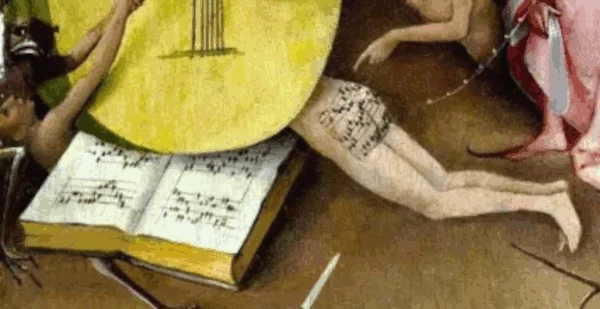
Sinner |
- Bosch is showing all the symbolism of sin in his garden
including giant instruments of music made into instruments of torture for musical sinners, and the choir of hell.
- The lute, harp and music book, the objects of his sin, crush a sinner.
Featuring Lucifer’s lutes, hell’s hurdy gurdy, Beelzebub’s bray harp, Diabolus’ drum, a recorder in the rectum, Satan’s shawm, a terrifying trumpet and triangle, a brazen bagpipe, and the unplayable music on the sinner’s bottom and in the book he is lying on. (openculture.com)
|
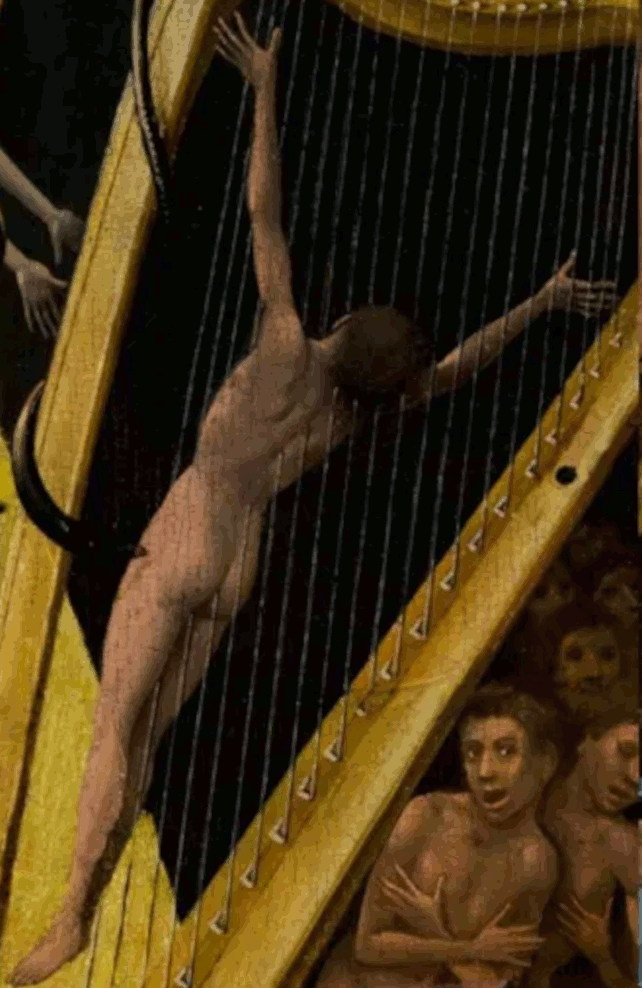
Harp |
- Harps were associated with King David, traditionally the composer of the Psalms, the Old Testament’s hymns of praise.
So it came about whenever the evil spirit from God came to Saul, David would take the harp and play it with his hand; and Saul would be refreshed and be well, and the evil spirit would depart from him.. (1 Samuel 16: 23:)
|
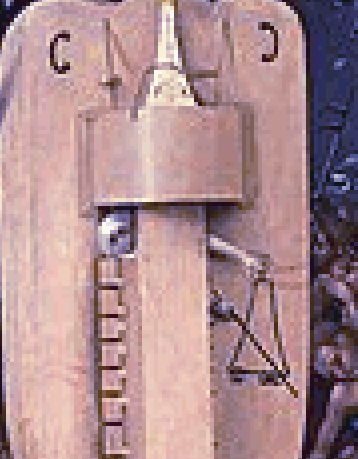
Keybox
Seattle
Space Needle |
- Bosch and his contemporaries viewed music as sinful, associating it with other sins of the flesh and spirit.
- A number of other instruments are also depicted:a shawm, a recorder, and the metal triangle being played by the woman (a nun, perhaps) who is apparently imprisoned in the keybox of the instrument.
- Bob Dylan's name backwards is Nalyd Bob (nail lid Bob) so
you see how they planned this life to cast a spell on you, and
how you can avoid them.
- We know who the Byrds
really are; Trump, Al Gore
Jr., George Jr., Pastor Bob and Terry Day Melcher.
Wait only for my boot heels to be wandering
I'm ready to go anywhere,
I'm ready for to fade
Into my own parade
Cast your dancing spell my way, I promise to go under it
(Mr.
Tambourine Man - Lyrics by
Bob Dylan, sung by the BYRDS)
|
|
|
What angel wakes me from my flow'ry bed?
Shakespeare, A Midsummer's Night Dream

|

